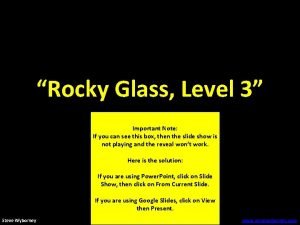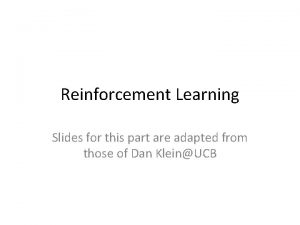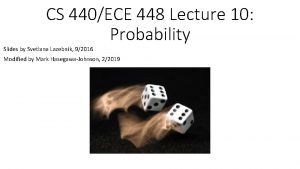This Set of Slides This set of slides































- Slides: 31

This Set of Slides • This set of slides deals with the nature of light, how it’s created, some ways that it’s used in astronomy. • Units covered: 21, 22, 23, 24 and 25.

Light • In Astronomy, it is far too difficult to visit stars and most planets in person. • Astronomers’ primary tool in learning about the universe is from the electromagnetic radiation, or light, that we can detect. • To understand how astronomers know what they know, you must understand some things about electromagnetic radiation - light.

The Nature of Light • Light is radiant energy. • Travels very fast – 300, 000 km/sec, 186, 000 miles/sec • Has a dual nature - Can be described either as a wave or as a particle traveling through space. • As a wave… – A disturbance in an electric field creates a magnetic field, which in turn creates an electric field, and so on, a self-propagating electromagnetic wave. – Light waves can constructively or destructively interfere. – The color of light is determined by its frequency. – The energy is also determined by frequency. • As a particle… – Particles of light (photons) travel through space. – These photons have very specific energies, that is, light is quantized. – Photons strike your eye (or other sensors) like very small, massless “balls” (maybe bb’s), and are detected.

Light as a Wave Versus Mechanical Waves • Wave – transfer of energy without the transfer of matter. • Wave phenomena – refraction, diffraction, constructive and destructive interference, superpositioning, Doppler shift. • Measurable wave characteristics – amplitude, wavelength, frequency, period. • Mechanical Waves – water, sound – must have some physical matter – a medium – in which to exist and travel. • Light exhibits all wave phenomena and has all the measurable wave characteristics (as a mechanical wave). • BUT, light does not require any physical matter for its transfer. Light can exist and travel through the vacuum of space.

Wavelength • The colors we see are determined by the wavelength of light. • Wavelength is the distance between successive crests (or troughs) in an electromagnetic wave. • This is very similar to the distance between the crests in ocean waves. • We denote the wavelength of light by the symbol . • Wavelengths of visible light are very small. – Red light has a wavelength of 7 10 -7 meters, or 700 nanometers (nm). – Violet light has a wavelength of 4 10 -7 meters, or 400 nm. – Colors in between red and violet (remember ROY G BIV? ) have intermediate wavelengths.

Frequency • Sometimes it is more convenient to talk about light in terms of frequency, or how fast successive crests pass by a given point. • You can think of frequency as a measure of how fast you bob up and down as the waves pass by. • Frequency has units of Hz (hertz), and is denoted by the symbol . 1 Hz = 1 cycle/sec. • Long wavelength light has a low frequency, and short wavelength light has a high frequency. • Frequency and wavelength are related by: Where ‘c’ is the speed of light.

White Light • Light from the Sun arrives with nearly all wavelengths, and we perceive this mixture of colors as white. • Newton demonstrated that white light could be split into its component colors with a prism, and then recombined into white light with a lens.

The Electromagnetic Spectrum I • There is much more to light than just visible light, the light that humans can see. – Radio waves have very long wavelengths, as much as a meter and more. – Microwaves (like the ones we cook with) are at the upper end of the radio part of the spectrum. – Infrared wavelengths are longer in wavelength than visible light.

The Electromagnetic Spectrum II • Above the visible… – Ultraviolet waves are shorter in wavelength than visible waves. These included the waves that tan or burn us. – X-rays come mostly from stellar sources in nature, and can penetrate many materials, like skin, muscle and bone. – Gamma rays have the shortest wavelengths.

Energy Carried by Photons • A photon carries energy with it that is related to its wavelength or frequency: • From this we see that long wavelength (low frequency) photons carry less energy than short wavelength (high frequency) ones. This is why UV waves give us a sunburn, and X-rays let us look through skin and muscles.

The Nature of Matter • An atom has a nucleus at its center containing protons and neutrons. • Outside of the nucleus, electrons move in “clouds” called orbitals. – Electrons can also be described using wave or particle models. – Electron orbitals are quantized – that is, they exist only at very specific energies. – The lowest energy orbital is called the ground state. • To move an electron from one orbital to the next higher one, a specific amount of energy must be added. Likewise, a specific amount of energy must be released for an electron to move to a lower orbital. • These are called electronic transitions.

Some Quantum versus Classical Mechanics • An early (circa 1900) atomic model was equivalent to a planetary model – the nucleus was considered to be like the Sun with the planet-like electrons in orbits. • This model didn’t last long. • An object (planet, moon, artificial satellite, space station) can be in orbit at any level as long as the speed is right. • An electron in an atom can not be in any “orbit” but only in very well-defined orbital levels. • An electron moves from one orbital to another without actually passing anywhere in-between! Another “oddity” of quantum mechanics!

The Chemical Elements • The number of protons (atomic number) in a nucleus determines what element a substance is. • An atom that is neutrally charged has a number of electrons equal to the number of protons. • The electron orbitals are different for each element, and the energy differences between the orbitals are unique as well. • This means that if we can detect the energy emitted or absorbed by an atom during an electronic transition, we can tell what element the atom belongs to, even from millions of light years away!

Absorption • If a photon of exactly the right energy (equal to the energy difference between orbitals) strikes an electron, that electron will absorb the photon and move into the higher orbital. – The atom is now in an excited state. • If the photon energy doesn’t match any of the orbital-energy differences it can not be absorbed – it will pass through. We say the element is transparent to those frequencies or colors. • This process is called absorption. • If the electron gains enough energy to leave the atom entirely, we say the atom is now ionized, or is an ion.

Emission • If an electron drops from one orbital to a lower one, it must emit a photon with the same amount of energy as the orbital-energy difference. • This is called emission.

Emission Spectra • Imagine that we have hot hydrogen gas. – Collisions among the hydrogen atoms cause electrons to jump up to higher orbitals, or energy levels. – Electrons can jump back to lower levels, and emit a photon of energy h x f. – If the electron falls from orbital 3 to orbital 2, the emitted photon will have a wavelength of 656 nm. – If the electron falls from orbital 4 to orbital 2, the emitted photon will have a wavelength of 486 nm. • We can monitor the light emitted, and measure the amount of light of each wavelength we see. If we graph this data, we’ll see an emission spectrum.

Seeing Spectra • Seeing the Sun’s spectrum is not difficult. – A narrow slit only lets a little light pass. – Either a grating or a prism splits the light into its component colors. – If we look closely at the spectrum, we can see dark lines. These correspond to wavelengths of light that were absorbed.

Emission spectrum of hydrogen • This spectrum is unique to hydrogen. • If we were looking at a hot cloud of interstellar gas in space, and saw these lines, we would know the cloud contained hydrogen.

Different atom, different spectrum! • Every element has its own spectrum. Note the differences between hydrogen and helium spectra below. A spectrum is like a chemical fingerprint!

Absorption Spectra • What if we had a cloud of cool hydrogen gas between us and a star? – Photons of energies that – – correspond to the electronic transitions in hydrogen will be absorbed by electrons in the gas. The light from those photons is effectively removed from the spectrum. The spectrum will have dark lines where the missing light would be. This is an absorption spectrum. Also unique for each element.

Types of Spectra - Summary * If the source emits light that is continuous, and all colors are present, we say that this is a continuous spectrum. * If the molecules in the gas are wellseparated and moving rapidly (have a high temperature), the atoms will emit characteristic frequencies of light. This is an emission-line spectrum. * If the molecules of gas are wellseparated, but cool, they will absorb light of a characteristic frequency as it passes through. This is an absorption line spectrum.

Spectra of Astronomical Objects

Measuring Temperature • It is useful to think of temperature in a slightly different way than we are accustomed to. – Temperature is a measure of the motion of atoms in an object. – Objects with low temperatures have atoms that are not moving much. – Objects with high temperatures have atoms that are moving around very rapidly. • The Kelvin temperature scale was designed to reflect this – 0 K is absolute zero –the atoms in an object are not moving at all.

The Blackbody Spectrum • As an object (piece of iron for example, or the gas in a star) is heated, the atoms in it start to move faster and faster. – When they collide, they emit photons with energy proportional to how hard they hit • Some collide lightly, and produce long-wavelength radiation. • Some collide very hard, and produce short-wavelength radiation. • Most are somewhere in Gentle collisions between. – As the body gets hotter, the number of collisions increase, and the number of hard collisions increase. Hard collisions

Results of More Collisions • Additional collisions mean that more photons are emitted, so the object gets brighter. • Additional hard collisions means that more photons of higher energy are emitted, so the object appears to shift in color from red, to orange, to yellow, and so on. • Of course we have physical laws to describe these effects.

Wien’s Law and the Stefan-Boltzmann Law • Wien’s Law: – Hotter bodies emit more strongly at shorter wavelengths. The hotter it is, the shorter the wavelengths. • SB Law: – The luminosity of a hot body rises rapidly with temperature.

Taking the Temperature of Astronomical Objects • Wien’s Law lets us estimate the temperatures of stars easily and fairly accurately. • We just need to measure the wavelength ( max) at which the star emits the most photons. • Then,

The Stefan-Boltzmann Law • If we know an object’s temperature (T), we can calculate how much energy the object is emitting using the SB law: • is the Stefan-Boltzmann constant, and is equal to 5. 67 10 -8 Watts/m 2/K 4 • The Sun puts out 64 million watts per square meter – lots of energy!

The Effect of Distance on Light • Light from a distant source seems very dim. Why? – Is it because the photons are losing energy? – No – the light is simply spreading out as it travels from its source to its destination. – The farther from the source you are, the dimmer the light seems. – The object’s brightness, or the amount of light received from a source, decreases with increased distance. The relationship is mathematical. This is an inverse-square law – the brightness decreases as the square of the distance (d) from the source.

Doppler Shift in Sound • You have experienced the Doppler shift in sound. – Standing on the sidewalk, listening as cars go past. – As a car approaches, the sound from the car seems to have a higher pitch – this is due to shorter wavelengths. – As the car passes, the sound shifts to lower pitch due to the longer wavelengths. – Police radar guns work on the same principle. The waves reflected off the car will be shifted by an amount that corresponds to the car’s speed.

Doppler Shift in Light • If an object emitting light is moving toward you, the light you see will be shifted to shorter wavelengths – toward the blue end of the spectrum. We say the light is blue-shifted. • Likewise, if the object is moving away from you, the light will be red-shifted. • If we detect a wavelength shift of away from the expected wavelength , the radial (line-ofsight) velocity of the object is:
 Training set validation set test set
Training set validation set test set Total set awareness set consideration set
Total set awareness set consideration set A small child slides down the four frictionless slides
A small child slides down the four frictionless slides A hockey puck sliding on smooth ice at 4 m/s
A hockey puck sliding on smooth ice at 4 m/s What is a transition headline
What is a transition headline Online media relations
Online media relations Cripsdm
Cripsdm Crisp set vs fuzzy set
Crisp set vs fuzzy set Surjective vs injective
Surjective vs injective Crisp set vs fuzzy set
Crisp set vs fuzzy set Crisp set vs fuzzy set
Crisp set vs fuzzy set Bounded set vs centered set
Bounded set vs centered set What is the overlap of data set 1 and data set 2?
What is the overlap of data set 1 and data set 2? Yuna wong war games
Yuna wong war games Templates
Templates Uml slides
Uml slides Googlw doc
Googlw doc Pte tanulmányi és vizsgaszabályzat
Pte tanulmányi és vizsgaszabályzat You exec plus
You exec plus Government purchase card training slides
Government purchase card training slides If h 0 the graph slides to the
If h 0 the graph slides to the Esti mysteries google slides
Esti mysteries google slides Software engineering slides
Software engineering slides Dbms component modules
Dbms component modules Olympics powerpoint presentation
Olympics powerpoint presentation Reinforcement learning slides
Reinforcement learning slides Holocene
Holocene Bru coffee slogan
Bru coffee slogan Probability slides
Probability slides Slides manja
Slides manja Emperor reduced trial ppt
Emperor reduced trial ppt What news does antonio receive as the play ends?
What news does antonio receive as the play ends?























































